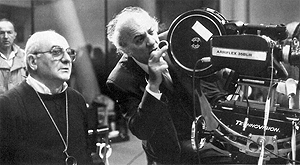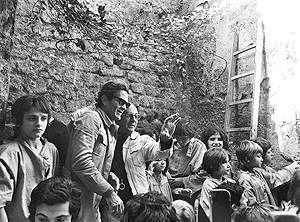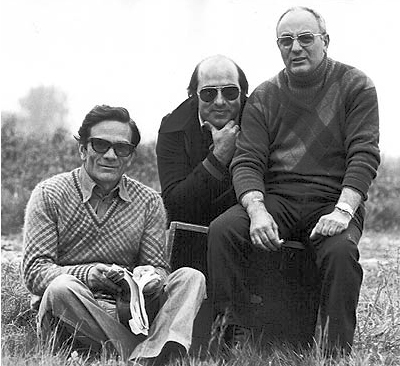Tonino Delli Colli
by Marc Salomon
One of the most prestigious Italian directors of photography since the war has disappeared with the death of Tonino Delli Colli. Throughout his impressive career covering more than half a century of cinema, with nearly 150 films, we find a host of directors as different as Mario Monicelli, Dino Risi, Pier Paolo Pasolini, Sergio Leone, Louis Malle, Marco Ferreri, Federico Fellini, Jean-Jacques Annaud and Roman Polanski.
He was born in Rome on November 20th 1923 and he began his career as camera assistant at Cinecitta when he was just 15 years old, working alongside Ubaldo Arata, Anchise Brizzi and Mario Albertelli.
By the age of 21, he was a director of photography (Finalmente sí) and he was responsible for the photography of fifty or so films before he finally met up with Pasolini in 1961.
From light comedies to melodramas, costume films to international coproductions, Delli Colli was the first DP to make an Italian film using the Ferraniacolor process in 1952 (Totò a colori) before turning to a more demanding film-making genre, “cinéma d’auteur”, where his constantly renewed, anti-conformist talent came into its own. Far from the somewhat pretentious conceptual approaches some people had towards light, Delli Colli declared, more modestly, “All I know is that the position of the first spotlight determines the rest. All the others depend on that. If you get the first spotlight wrong, the whole lot goes to pot.”
Even though a contract signed with two producers - Carlo Ponti and Dino Laurentiis - in the 1950s guaranteed him five films a year, Delli Colli was keen on changing his style and he planned a meeting with Pasolini and accepted a lower salary, “I believe in fate, because that meeting completely changed my career”, he explained to the American Cinematographer.

« With Accattone, Tonino Delli Colli, who was used to working on very high quality but more commercial films (Italian comedies that were great successes but perhaps less refined from a photography point of view), changed when he met Pasolini”, declared his fellow cinematographer and countryman, Giuseppe Lanci. “From then on, he only made films that were extremely interesting from a photographic point of view. This means that his meeting with someone like Pasolini [...] lit a sort of spark in someone as sensitive as Tonino”.
Encouraged by Pasolini, he experimented with different processing methods for Ferrania P30 B&W film : bright whites and marked contrasts, obtained using filters and duplicating the film in the case of Accatone ; grey but never dull images, faces and landscapes that form outlines in neighbouring tones of grey, where the light seems to rise up in The Gospel According to Saint Matthew. The frequent use of a hand-held camera (Arri IIC) and zoom effects (35-140 mm Angénieux) then seem quite unusual, but they blend together during perfectly smooth editing (far more convincing than Rossellini’s or Visconti’s work...).
With Sergio Leone, he redesigned the Western (following on from Massimo Dallamano) : original Scope compositions, a shiny and coppery glint to skin (wonderful work on complexions browned by the sun), warm ochre tones in the photography that inspired a whole host of Americans from Clint Eastwood and his DP Bruce Surtees to Dante Spinotti (Sam Raïmi’s Dead or Alive in 1994).
For one of the sequences in Mamma Roma, the director wanted Delli Colli to draw inspiration from paintings by Jacopo Pontormo.
In some ways he was the opposite to Storaro, because of his ability to instinctively comply with different environments, which made him one of the most exciting Italian DPs since the war.
It is interesting to note that he was cast as himself in Fellini’s Intervista. He made 11 films with Pasolini.
He trained other DPs such as Pallottini, Ruzzolini, Franco Delli Colli and Franco Di Giacomo...
“I have always relied more on intuition than on technique.”
“I have my own method for shooting outdoors but I won’t tell you what it is.” (Tonino Delli Colli)
Various press articles have been devoted to Tonino Delli Colli, including a homage by the American Cinematographer in March 2005 (A Lifetime Through the Lens), as well as articles on the subject of In the Name of the Rose (October 1986) and La Jeune fille et la mort (April 1996).
There were interviews with Delli Colli in the August 2003 edition of Film & TV Kameramann and in a book by S. Consiglio & F. Ferzetti, entitled La bottega della luce published in 1983, as well as in La Luce e la Sceneggiatura, an AIC publication released in 2003.

Filmography in French shortened by Marc Salomon of Tonino Delli Colli
 En
En Fr
Fr



